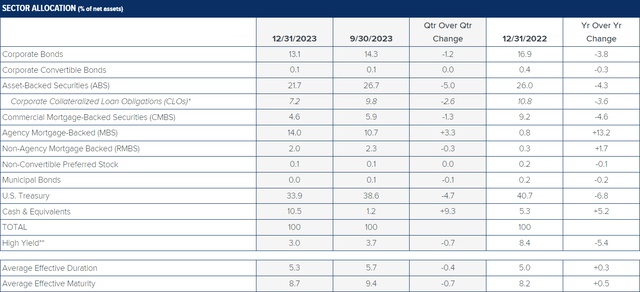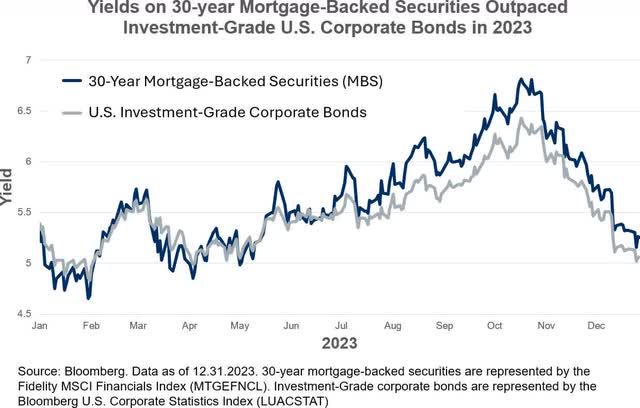The Core Plus Income Fund’s Institutional Class (MUTF:WCPBX) returned +5.84% for the fourth quarter compared to a +6.82% return for the Bloomberg U.S. Aggregate Bond Index (Agg). For the calendar year, the Fund’s Institutional Class returned +7.05% compared to +5.53% for the index. Longer-term results (3-, 5-, and 7-year) continue to outpace the index.
Overview
(from Fixed Income Insights: Bonds are Back, Redux)
A year ago, we penned a piece titled “Bonds Are Back / Return of Income” after a brutal 2022. It seems fitting to revisit since, for much of 2023, fixed income investors were smarting from a seemingly relentless increase in U.S. Treasury interest rates across the yield curve (as well as other segments of the bond market) as the Federal Reserve instituted four additional short-term rate hikes to combat declining- but-still-high inflation readings. Broad interest rate declines in early 2023, accelerated by historic regional bank failures that caused massive deposit flight, reversed by mid-year and began a climb that saw trough-to-peak changes in U.S. Treasury interest rates of approximately 1.5% (150 basis points) across the yield curve, from 2-year to 30-year bonds. In October 10-year and 30-year Treasury bond rates briefly breached 5% for the first time in more than 16 years. However, midway through the fourth quarter, ebbing inflation levels, a slower pace of employment growth, and the long-forecasted Fed ‘pivot’ or pause in
its monetary tightening policy, propelled a powerful fixed income rally. By year-end, fixed income and equity investors were seeing strong overall returns, as the growth below highlights. Treasuries managed to avoid a three-year negative return record by posting modest positive results – with every other credit- sensitive asset class (e.g. investment-grade and high-yield corporate bonds as well as leveraged loans) generating solid results.
Portfolio Positioning
The table below shows the change in allocation to various sectors, from the prior quarter and from the prior year. This summary provides a view over time of how we have allocated capital. Since our goal is to invest in sectors that we believe offer the best risk-adjusted returns, our allocations may change significantly over time.

|
*Corporate CLOs are included in the ABS segment in the Fund’s schedule of investments but are additionally called out separately for the purposes of the discussion. **For the current period, high yield exposure consists of investments in the Corporate, Corporate Convertible, ABS, and CMBS sectors. |
The most notable change in sector allocation during the fourth quarter (and for the calendar year) was an increase in mortgage-backed securities (MBS). The Fund had not had a meaningful investment in MBS in its nine-year life, but that all changed in 2023. Most of our MBS investments occurred over the past three quarters, where over 15% of Fund assets were deployed, primarily in agency (Fannie Mae and Freddie Mac) MBS, but also in prime jumbo MBS (mortgages too large to be eligible for inclusion in agency MBS).
What changed? Since the Great Financial Crisis, the Federal Reserve was an active and large buyer of agency MBS via its various quantitative easing (‘QE’) campaigns. From no exposure at the end of 2008, the Fed accumulated nearly $2.75 trillion of agency MBS. This action helped keep mortgage rates lower than they might otherwise have been – and led to, we believed, less attractive opportunities to invest in that part of the fixed income marketplace. Last year, the Fed stopped accumulating MBS and allowed its portfolio to shrink, however modestly, via quantitative tightening (‘QT’). And the early part of 2023 saw three of the largest bank failures in U.S. history, which resulted in a meaningful reduction, if not exodus, by many banks (especially regional) from the MBS marketplace.

With key MBS buyers no longer present, and with increased interest rate volatility, the market repriced MBS spreads meaningfully wider/ higher than they had been, as measured by the difference between current production/coupon MBS and the average price of 5- and 10-year Treasury bonds. As illustrated in the chart to the right, wider MBS spreads in the second half of the year produced an environment where agency MBS yields (blue line) exceeded those of investment grade corporate bonds (gray line). This has rarely occurred over the past 20 years.
In addition to MBS, we added Treasury securities, principally in 20-year maturities. We also added to our auto and consumer ABS holdings, primarily via the new issue market. In collateralized loan obligations (CLOs), we invested in new issue commercial real estate (‘CRE’) CLOs from H.I.G. Realty Credit Investments and two new middle- market CLO sponsors, Barings and PGIM.
In terms of overall portfolio metrics, the Fund’s average effective maturity decreased to 8.7 years as of December 31, 2023, from 9.4 years as of September 30, 2023, while the average effective duration decreased to 5.3 years from 5.7 years over the same time period, compared to the Agg’s average effective duration of 6.2 years on December 31. These measures provide a guide to the Fund’s interest rate sensitivity. A higher average effective duration increases the Fund’s price sensitivity to changes in interest rates (either up or down).
|
Yield to Worst / Duration Analysis |
||||
|
12/31/22 |
12/31/23 |
Change |
% Change |
|
|
Yield to Worst (%) |
||||
|
Core Plus Income Fund |
0.6 |
0.7 |
-0.1 |
1.4 |
|
U.S. Agg Index |
21.5 |
18.4 |
+3.1 |
26.1 |
|
Average Duration (yrs) |
||||
|
Core Plus Income Fund |
1.4 |
1.8 |
-0.4 |
0.7 |
|
U.S. Agg Index |
0.6 |
0.9 |
-0.3 |
1.3 |
As of December 31, our high-yield exposure as a percent of net assets was 3.0%, down from 3.7% on September 30, 2023. The Fund can invest up to 25% of net assets in high yield, therefore we have ample capacity to take advantage of valuation discrepancies/opportunities in the high yield area.
Per the table to the right, the Fund’s yield to worst (‘YTW’) remains higher than the Bloomberg U.S. Aggregate Bond index, while the Fund’s interest rate risk (duration) continues to be lower. Constructing a portfolio that produces ‘carry’ – income achieved from regular coupon payments – (via the YTW measurement) and lower interest rate sensitivity (via lower duration) is a feature of our flexible mandate and ability to invest in other higher-quality securities that reside outside of the index.
Top Quarterly Contributors
U.S. Treasury Bonds: U.S. Treasuries were the largest contributor to performance. With a duration of over 10 years, our Treasury portfolio experienced unrealized mark-to-market gains as interest rates declined significantly during the quarter.
Asset Backed Securities: Our ABS portfolio, including collateralized loan obligations, provided modest price appreciation and high coupon income.
Agency mortgage-backed securities (MBS): Our agency MBS performed well as interest rates fell and mortgage-backed spreads declined during the quarter.
Top Quarterly Detractors
There were no material detractors in the fourth quarter.
Normal for Longer?
A significant amount of press has focused on the possibility of interest rates staying “higher for longer.” Having painful memories of what approximated ‘zero forever’ during the ZIRP (zero interest-rate policy) days, we’d welcome a return of some semblance of normalcy to interest rates overall, where rates are determined in a world less manipulated by central banks. This would benefit investors and decision makers of all types, from savers in money market funds to investors of capital all along the yield curve. And ultimately, it would lead to more rational investment decisions à la philosopher/economist Adam Smith’s “invisible hand” (metaphor describing unseen forces of self-interest that impact free markets).
As we embark on a new year where everyone’s investment results are reset to zero, it certainly is plausible that the strong bond market rally to end 2023 may have borrowed from 2024 returns (the first week of the new year seems to support this). Either way, we believe the prospects for fixed-income investors coupled with an easing (if not plateauing) inflationary backdrop continue to provide a compelling environment for both nominal and, in particular, real (after inflation) return opportunities. If this describes “normal for longer,” we can be tempted to reiterate, cliché or not, that ‘bonds are back’ – especially from an income perspective.
Fund Strategy
Our approach consists primarily of investing in a diversified portfolio of high-quality bonds while maintaining an overall portfolio average duration of 3.5 to 7 years. We may seek to capture attractive coupon income and potential price appreciation by investing in longer-duration and lower- quality bonds when attractively priced. We may also invest up to 25% in fixed income securities that are not considered investment grade (such as high-yield and convertible bonds as well as preferred and convertible preferred stock), and we do so when we perceive the risk/reward characteristics to be favorable.
We do not, and will not, try to mimic any particular index as we construct our portfolio. We believe our flexible mandate and high-conviction portfolio will benefit investors over the long term. We utilize a bottom-up, research-driven approach and select portfolio assets one security at a time based on our view of opportunities in the marketplace. Our fixed income research is not dependent on, but often benefits from, the due diligence work our equity teammates conduct on companies and industries.
Overall, we strive to be adequately compensated for the risks assumed in order to maximize investment (or reinvestment) yield and to avoid making interest rate bets, particularly those that depend on interest rates going down. We have often maintained a lower duration profile than the index, particularly in very low-yield environments. Our shorter duration profile has benefited shareholders in periods of rising interest rates.
Maintaining a diversified portfolio and liquidity reserves is a key element of our risk management approach. As a result, we have not held back from owning U.S. Treasury bonds and, at times like now, cash reserves. We believe this approach has served our clients well, particularly in extreme market environments like the pandemic brought upon us in March 2020.
 This material must be preceded or accompanied by a prospectus or summary prospectus. Data is for the quarter ending 12/31/2023. The opinions expressed are those of Weitz Investment Management and are not meant as investment advice or to predict or project the future performance of any investment product. The opinions are current through 01/20/2024, are subject to change at any time based on market and other current conditions, and no forecasts can be guaranteed. This commentary is being provided as a general source of information and is not intended as a recommendation to purchase, sell, or hold any specific security or to engage in any investment strategy. Investment decisions should always be made based on an investor’s specific objectives, financial needs, risk tolerance and time horizon. Data quoted is past performance and current performance may be lower or higher. Past performance is no guarantee of future results. Investment return and principal value of an investment will fluctuate, and shares, when redeemed, may be worth more or less than their original cost. Please visit weitzinvestments.com for the most recent month-end performance. Investment results reflect applicable fees and expenses and assume all distributions are reinvested but do not reflect the deduction of taxes an investor would pay on distributions or share redemptions. Net and Gross Expense Ratios are as of the Fund’s most recent prospectus. Certain Funds have entered into fee waiver and/or expense reimbursement arrangements with the Investment Advisor. In these cases, the Advisor has contractually agreed to waive a portion of the Advisor’s fee and reimburse certain expenses (excluding taxes, interest, brokerage costs, acquired fund fees and expenses and extraordinary expenses) to limit the total annual fund operating expenses of the Class’s average daily net assets through 07/31/2024. The Gross Expense Ratio reflects the total annual operating expenses of the fund before any fee waivers or reimbursements. The Net Expense Ratio reflects the total annual operating expenses of the Fund after taking into account any such fee waiver and/or expense reimbursement. The net expense ratio represents what investors are ultimately charged to be invested in a mutual fund. Index performance is hypothetical and is shown for illustrative purposes only. You cannot invest directly in an index. The Bloomberg U.S. Aggregate Bond index is a broad-based benchmark that measures the investment grade, U.S. dollar-denominated, fixed-rate taxable bond market. Holdings are subject to change and may not be representative of the Fund’s current or future investments. Credit ratings are assigned to underlying securities utilizing ratings from a Nationally Recognized Statistical Rating Organization (NRSRO) such as Moody’s and Fitch, or other rating agencies and applying the following hierarchy: security is determined to be Investment Grade if it has been rated at least BBB- by one credit rating agency; once determined to be Investment Grade (BBB- and above) or Non-Investment Grade (BB+ and below) where multiple ratings are available, the lowest rating is assigned. Mortgage-related securities issued and guaranteed by government-sponsored agencies such as Fannie Mae and Freddie Mac are generally not rated by rating agencies. Securities that are not rated do not necessarily indicate low quality. Ratings are shown in the Fitch scale (e.g., AAA). Ratings and portfolio credit quality may change over time. The Fund itself has not been rated by a credit rating agency. Definitions: 30-Day SEC Yield represents net investment income earned by a fund over a 30-day period, expressed as an annual percentage rate based on the Fund’s share price at the end of the 30-day period. Average effective duration provides a measure of a fund’s interest-rate sensitivity. The longer a fund’s duration, the more sensitive the fund is to shifts in interest rates. Average effective maturity is the weighted average of the maturities of a fund’s underlying bonds. Commercial real estate collateralized loan obligations (CRE CLOs) are a type of asset-backed security backed by a pool of commercial loans. Distribution yield is a measure of yield calculated by taking a fund’s most recent income distribution payment divided by its net asset value (‘NAV’) and expressed as an annual rate. Investment Grade Bonds are those securities rated at least BBB- by one or more credit ratings agencies. Middle market CLOs refer to collateralized loan obligations backed by loans made to smaller companies, which companies generally have earnings before interest, taxes, and amortization of less than $75 million. Non-Investment Grade Bonds are those securities (commonly referred to as “high yield” or “junk” bonds) rated BB+ and below by one or more credit ratings agencies. Subsidized yield reflects fee waivers and/or expense reimbursements during the period. Without such fee waivers and/or expense reimbursements, if any; yields would have been lower. Unsubsidized yield does not adjust for any fee waivers and/or expense reimbursement in effect. Yield to worst (YTW) is the lowest potential yield that can be received on a bond portfolio without the underlying issuers defaulting. Consider these risks before investing: All investments involve risks, including possible loss of principal. Market risk includes political, regulatory, economic, social and health risks (including the risks presented by the spread of infectious diseases). Changing interest rates may have sudden and unpredictable effects in the markets and on the Fund’s investments. The Fund may purchase lower-rated and unrated fixed-income securities, which involve an increased possibility that the issuers of these may not be able to make payments of interest and principal. See the Fund’s prospectus for a further discussion of risks. Investors should consider carefully the investment objectives, risks, and charges and expenses of a fund before investing. This and other important information is contained in the prospectus and summary prospectus, which may be obtained at weitzinvestments.com or from a financial advisor. Please read the prospectus carefully before investing. Weitz Securities, Inc. is the distributor of the Weitz Funds. |
Original Post
Editor’s Note: The summary bullets for this article were chosen by Seeking Alpha editors.
Read the full article here













